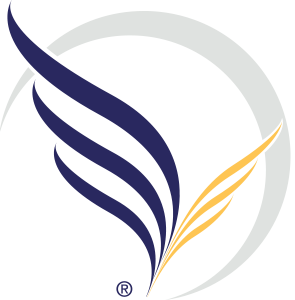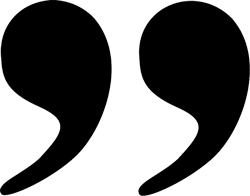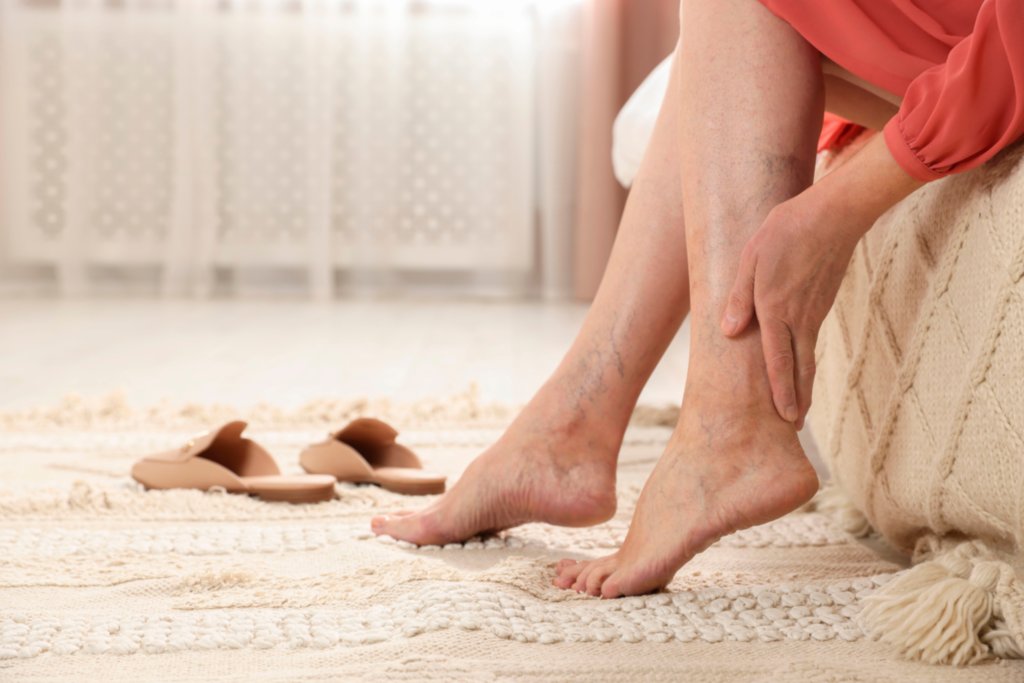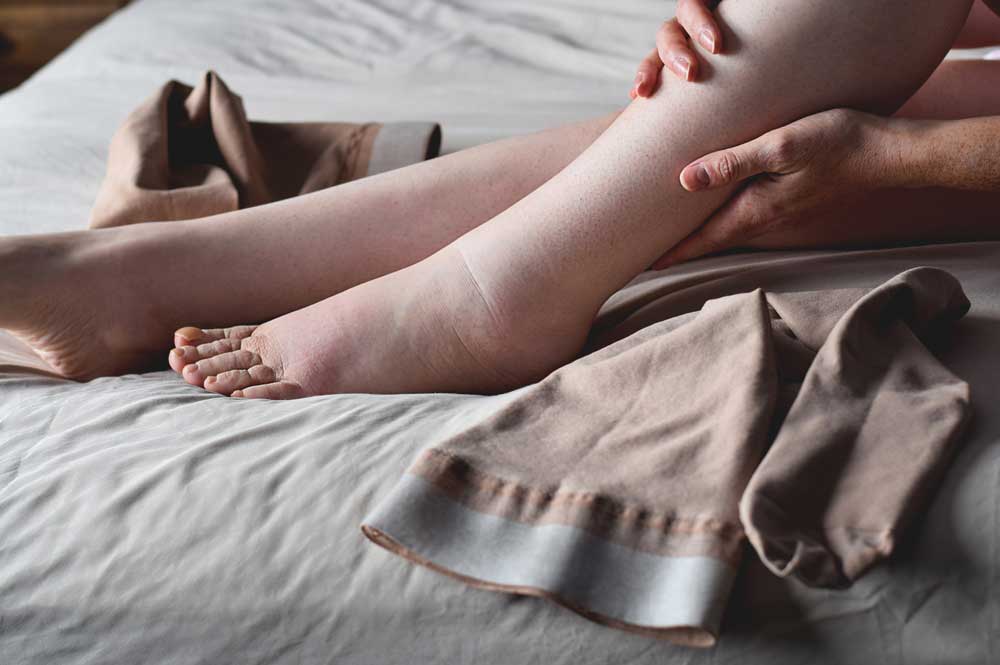If you’ve noticed small, web-like veins on your legs or face, you might be tempted to dismiss them as a purely cosmetic concern. Many people in their 30s, 40s and 50s make this assumption about spider veins, thinking they’re simply an inevitable part of aging that doesn’t require medical attention. However, the truth about spider veins is more complex than expected.
While spider veins may seem like a minor aesthetic issue, they can sometimes signal underlying vascular problems that deserve proper evaluation. Understanding what spider veins really are and when they require treatment can help you make informed decisions about your vascular health.
What Are Spider Veins Really?
Spider veins, medically known as telangiectasias, are small damaged blood vessels that appear close to the skin’s surface. These tiny vessels often resemble spider webs or tree branches and can appear in red, blue, green or purple colors. They develop when the tiny, one-way valves inside veins weaken, allowing blood to flow backward and accumulate in the vessel.
In healthy veins, these valves direct the blood in one direction back to the heart. When valves weaken, blood pools in the vein, putting pressure on the vein walls. With continual pressure, the walls weaken and bulge, creating a visible spider-like appearance.
Understanding the mechanics behind spider vein formation is crucial because it reveals why these seemingly minor cosmetic issues can sometimes indicate more serious circulation problems. The same valve dysfunction that creates visible spider veins may be affecting deeper, larger veins in ways that aren’t immediately apparent.
The Hidden Signs: When Spider Veins Signal Something More
While many spider veins are indeed primarily cosmetic, they can sometimes indicate more significant vascular issues, especially when accompanied by specific symptoms:
Early Warning Symptoms to Watch For
If you’re experiencing any of these symptoms alongside your spider veins, it’s time to stop treating them as merely cosmetic.
- Aching or burning sensations in areas where spider veins appear may suggest underlying venous insufficiency. This discomfort often worsens after long periods of standing or sitting and may be dismissed as normal fatigue when it’s actually a sign of poor circulation.
- Swelling around spider vein clusters, particularly in the ankles or lower legs, can indicate that your circulatory system struggles to move blood efficiently back to your heart. This swelling may be subtle initially, appearing only at the end of long days or during hot weather.
- Restless leg syndrome or leg cramps, especially at night, sometimes correlate with vascular problems that manifest as spider veins during the day. Many people don’t connect nighttime leg discomfort with daytime vein appearance, but the relationship is often significant.
- Skin changes such as dry, itchy skin or darkening around spider veins may signal that your circulation needs professional evaluation. These changes indicate that tissues aren’t receiving optimal blood flow and nutrients.
- Heaviness or fatigue in the legs that seems disproportionate to your activity level can be an early sign that your venous system is working harder than it should to circulate blood effectively.
Age Matters: Why Your 30s, 40s and 50s Are Critical Decades
Spider veins often first appear during these pivotal decades for several reasons that go beyond simple aging:
Hormonal changes, particularly in women, can weaken vein walls significantly. Pregnancy, menopause and hormone replacement therapy all affect circulation patterns. Estrogen and progesterone fluctuations can cause vein walls to relax and valves to become less effective, creating the perfect environment for spider vein development.
Career demands often involve prolonged sitting or standing, leading to vein problems. You’re at higher risk if your job keeps you in one position for extended periods during the day. Office workers, teachers, healthcare professionals and retail employees are particularly susceptible due to their occupational demands.
Family history becomes more apparent during these years. Genetic predisposition to vein problems often manifests in middle age, with inherited weaknesses in vein wall structure or valve function becoming evident as other risk factors accumulate.
Lifestyle factors such as weight gain, reduced activity levels and sun exposure accumulate over time, contributing to spider vein development. The cumulative effect of years of sun damage, coupled with decreased muscle tone that normally helps pump blood back to the heart, creates ideal conditions for vein problems.
The Progressive Nature of Vein Problems
One crucial fact many people don’t realize is that vein problems are typically progressive. What starts as a few small spider veins may develop into more significant issues over time if underlying circulation problems aren’t addressed.
Venous insufficiency can worsen gradually, leading to larger varicose veins, chronic swelling and even skin ulcers in severe cases. Early intervention when spider veins first appear can prevent these more serious complications and save you from more extensive treatments later.
Symptom progression often follows a predictable pattern: cosmetic concerns first, then mild discomfort, followed by more significant pain and functional problems if left untreated. Understanding this progression helps explain why early evaluation and treatment are so critical.
Connection to deeper problems: Spider veins can sometimes be the visible manifestation of the issues in deeper veins that aren’t apparent on the surface. A comprehensive evaluation can identify these underlying issues before they cause more serious symptoms.
Risk Factors You Can’t Ignore
Several factors significantly increase your risk of developing spider veins that require medical attention:
Pregnancy puts enormous pressure on leg veins and can cause permanent valve damage. Multiple pregnancies increase this risk exponentially, with each pregnancy potentially causing additional vein problems.
Obesity increases pressure on leg veins and reduces the muscle pump action that helps circulate blood. Even modest weight gain can significantly impact circulation in people genetically predisposed to vein problems.
Prolonged sun exposure, particularly to the legs and face, can weaken blood vessel walls and contribute to spider vein formation. This is why spider veins on the face are often more common in people with a significant sun exposure history.
Previous injury or trauma to the legs can damage veins and valves, creating areas where spider veins are more likely to develop later in life.
A sedentary lifestyle poses additional risks, causing a lack of much-needed circulation in your legs. Movement throughout the day, including frequent breaks from sitting and exercise sessions, is necessary for overall body and vein health.
When to Seek Professional Evaluation
Even if your spider veins seem purely cosmetic, a professional evaluation can provide peace of mind and establish a baseline for monitoring future changes. Consider a professional assessment if you experience:
- Spider veins that develop suddenly or in large clusters
- Any pain, burning or aching associated with spider veins
- Swelling in areas where spider veins appear
- Changes in skin color or texture around spider veins
- Family history of serious vein problems
- Lifestyle factors that put you at higher risk
- Concerns about the appearance affecting your quality of life
- Questions about treatment options and their appropriateness for your situation
Treatment Options: More Than Just Cosmetic Solutions
Modern spider vein treatments offer both cosmetic improvement and medical benefits. Both treatments can improve circulation and enhance appearance, simultaneously addressing cosmetic and medical concerns.
Sclerotherapy remains the gold standard for spider vein treatment. This minimally invasive procedure involves injecting a special solution directly into spider veins, causing them to collapse and fade. With 70-80% fading of visible spider veins achievable through a series of treatments, sclerotherapy offers proven effectiveness with minimal downtime. The procedure typically takes 20-30 minutes, allowing you to return to normal activities immediately.
Laser therapy provides a noninvasive alternative, particularly effective for small spider veins and those on the face. Advanced laser systems can target veins precisely while protecting surrounding skin. This treatment is ideal for people who prefer to avoid needles or have veins too small for injection. We are proud to partner with Spa Medical to address all your laser needs!
Combination approaches often provide the best results. Your vein specialist will determine the optimal treatment plan based on your specific vein pattern, size and location.
Insurance Coverage: Understanding Your Options
Many treatment options may be covered by insurance for underlying venous problems, especially if you have symptoms of pain, swelling, or other functional issues.. However, spider veins are considered cosmetic in nature by most plans.
During your consultation, our team can help determine whether your specific situation qualifies for insurance coverage. Documentation of symptoms, physical examination findings and diagnostic testing results is essential in insurance coverage decisions.
Even when treatments are considered cosmetic, many patients find the investment worthwhile for the confidence and comfort improvements they experience. The psychological benefits of feeling confident about your legs’ appearance shouldn’t be underestimated.
Why Choose Vein Specialists of the South
When it comes to your vascular health, experience and expertise matter. Vein Specialists of the South offers the comprehensive care you need with the credentials you can trust.
Dr. Kenneth Harper brings over 25 years of specialized experience in vein care. He was one of the first physicians to become a Diplomat of the American Board of Venous and Lymphatic Medicine (AMVLM) and is Board Certified by the American Board of Surgery (ABS). Since 2000, Dr. Harper has evaluated over 22,000 patients and performed over 18,000 procedures.
Accredited Excellence: Our vascular ultrasound lab and procedure facility are accredited through the Intersocietal Accreditation Commission (IAC), ensuring you receive the highest standard of care with accurate diagnostic testing and safe procedures.
Innovation Leaders: VSS introduced the first endovenous closure procedure to Georgia in the early 2000s and remains at the forefront of vein treatment advances.
Research Recognition: Our team participates in nationally recognized vein research, which was recognized at the Annual Congress of the American College of Phlebology, including the Platinum Research Award in 2007.
Educational Excellence: Providers nationwide come to VSS to learn from our Comprehensive Vein Training Center specialists, demonstrating our leadership in the field.
Take Action for Your Health
Spider veins don’t have to be something you simply accept or ignore. Whether your concerns are primarily cosmetic or you’re experiencing symptoms that suggest underlying vascular issues, professional evaluation is the first step toward healthier, more beautiful legs.
Early treatment is often more effective and less extensive than waiting until problems progress. By addressing spider veins now, you can prevent potential complications while improving your legs’ appearance and health.
Our experienced team at Vein Specialists of the South is ready to evaluate your specific situation, discuss treatment options and create a personalized plan to address both your cosmetic concerns and any underlying vascular issues. Take the first step toward healthier, more beautiful legs by calling (478) 743-2472 now.









